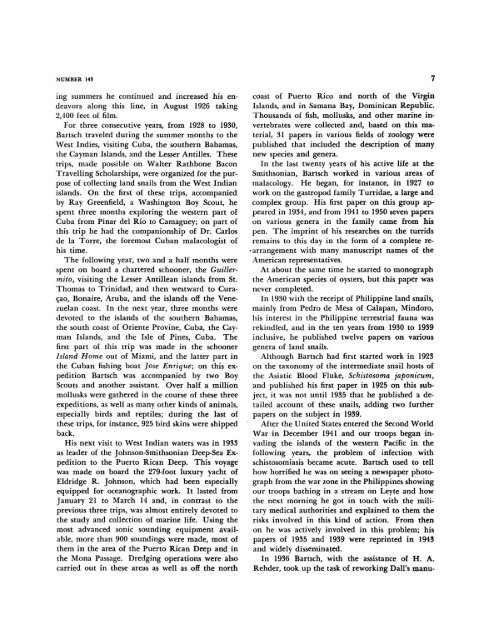Bibliography and Zoological Taxa of Paul Bartsch - Smithsonian ...
Bibliography and Zoological Taxa of Paul Bartsch - Smithsonian ...
Bibliography and Zoological Taxa of Paul Bartsch - Smithsonian ...
Create successful ePaper yourself
Turn your PDF publications into a flip-book with our unique Google optimized e-Paper software.
NUMBER 143<br />
ing summers he continued <strong>and</strong> increased his endeavors<br />
along this line, in August 1926 taking<br />
2,400 feet <strong>of</strong> film.<br />
For three consecutive years, from 1928 to 1930,<br />
<strong>Bartsch</strong> traveled during the summer months to the<br />
West Indies, visiting Cuba, the southern Bahamas,<br />
the Cayman Isl<strong>and</strong>s, <strong>and</strong> the Lesser Antilles. These<br />
trips, made possible on Walter Rathbone Bacon<br />
Travelling Scholarships, were organized for the purpose<br />
<strong>of</strong> collecting l<strong>and</strong> snails from the West Indian<br />
isl<strong>and</strong>s. On the first <strong>of</strong> these trips, accompanied<br />
by Ray Greenfield, a Washington Boy Scout, he<br />
spent three months exploring the western part <strong>of</strong><br />
Cuba from Pinar del Rio to Camaguey; on part <strong>of</strong><br />
this trip he had the companionship <strong>of</strong> Dr. Carlos<br />
de la Torre, the foremost Cuban malacologist <strong>of</strong><br />
his time.<br />
The following year, two <strong>and</strong> a half months were<br />
spent on board a chartered schooner, the Guillermito,<br />
visiting the Lesser Antillean isl<strong>and</strong>s from St.<br />
Thomas to Trinidad, <strong>and</strong> then westward to Curasao,<br />
Bonaire, Aruba, <strong>and</strong> the isl<strong>and</strong>s <strong>of</strong>f the Venezuelan<br />
coast. In the next year, three months were<br />
devoted to the isl<strong>and</strong>s <strong>of</strong> the southern Bahamas,<br />
the south coast <strong>of</strong> Oriente Provine, Cuba, the Cayman<br />
Isl<strong>and</strong>s, <strong>and</strong> the Isle <strong>of</strong> Pines, Cuba. The<br />
first part <strong>of</strong> this trip was made in the schooner<br />
Isl<strong>and</strong> Home out <strong>of</strong> Miami, <strong>and</strong> the latter part in<br />
the Cuban fishing boat Jose Enrique; on this expedition<br />
<strong>Bartsch</strong> was accompanied by two Boy<br />
Scouts <strong>and</strong> another assistant. Over half a million<br />
mollusks were gathered in the course <strong>of</strong> these three<br />
expeditions, as well as many other kinds <strong>of</strong> animals,<br />
especially birds <strong>and</strong> reptiles; during the last <strong>of</strong><br />
these trips, for instance, 925 bird skins were shipped<br />
back.<br />
His next visit to West Indian waters was in 1933<br />
as leader <strong>of</strong> the Johnson-<strong>Smithsonian</strong> Deep-Sea Expedition<br />
to the Puerto Rican Deep. This voyage<br />
was made on board the 279-foot luxury yacht <strong>of</strong><br />
Eldridge R. Johnson, which had been especially<br />
equipped for oceanographic work. It lasted from<br />
January 21 to March 14 <strong>and</strong>, in contrast to the<br />
previous three trips, was almost entirely devoted to<br />
the study <strong>and</strong> collection <strong>of</strong> marine life. Using the<br />
most advanced sonic sounding equipment available,<br />
more than 900 soundings were made, most <strong>of</strong><br />
them in the area <strong>of</strong> the Puerto Rican Deep <strong>and</strong> in<br />
the Mona Passage. Dredging operations were also<br />
carried out in these areas as well as <strong>of</strong>f the north<br />
coast <strong>of</strong> Puerto Rico <strong>and</strong> north <strong>of</strong> the Virgin<br />
Isl<strong>and</strong>s, <strong>and</strong> in Samana Bay, Dominican Republic.<br />
Thous<strong>and</strong>s <strong>of</strong> fish, mollusks, <strong>and</strong> other marine invertebrates<br />
were collected <strong>and</strong>, based on this material,<br />
31 papers in various fields <strong>of</strong> zoology were<br />
published that included the description <strong>of</strong> many<br />
new species <strong>and</strong> genera.<br />
In the last twenty years <strong>of</strong> his active life at the<br />
<strong>Smithsonian</strong>, <strong>Bartsch</strong> worked in various areas <strong>of</strong><br />
malacology. He began, for instance, in 1927 to<br />
work on the gastropod family Turridae, a large <strong>and</strong><br />
complex group. His first paper on this group appeared<br />
in 1934, <strong>and</strong> from 1941 to 1950 seven papers<br />
on various genera in the family came from his<br />
pen. The imprint <strong>of</strong> his researches on the turrids<br />
remains to this day in the form <strong>of</strong> a complete re-<br />
' arrangement with many manuscript names <strong>of</strong> the<br />
American representatives.<br />
At about the same time he started to monograph<br />
the American species <strong>of</strong> oysters, but this paper was<br />
never completed.<br />
In 1930 with the receipt <strong>of</strong> Philippine l<strong>and</strong> snails,<br />
mainly from Pedro de Mesa <strong>of</strong> Calapan, Mindoro,<br />
his interest in the Philippine terrestrial fauna was<br />
rekindled, <strong>and</strong> in the ten years from 1930 to 1939<br />
inclusive, he published twelve papers on various<br />
genera <strong>of</strong> l<strong>and</strong> snails.<br />
Although <strong>Bartsch</strong> had first started work in 1923<br />
on the taxonomy <strong>of</strong> the intermediate snail hosts <strong>of</strong><br />
the Asiatic Blood Fluke, Schistosoma japonicum,<br />
<strong>and</strong> published his first paper in 1925 on this subject,<br />
it was not until 1935 that he published a detailed<br />
account <strong>of</strong> these snails, adding two further<br />
papers on the subject in 1939.<br />
After the United States entered the Second World<br />
War in December 1941 <strong>and</strong> our troops began invading<br />
the isl<strong>and</strong>s <strong>of</strong> the western Pacific in the<br />
following years, the problem <strong>of</strong> infection with<br />
schistosomiasis became acute. <strong>Bartsch</strong> used to tell<br />
how horrified he was on seeing a newspaper photograph<br />
from the war zone in the Philippines showing<br />
our troops bathing in a stream on Leyte <strong>and</strong> how<br />
the next morning he got in touch with the military<br />
medical authorities <strong>and</strong> explained to them the<br />
risks involved in this kind <strong>of</strong> action. From then<br />
on he was actively involved in this problem; his<br />
papers <strong>of</strong> 1935 <strong>and</strong> 1939 were reprinted in 1943<br />
<strong>and</strong> widely disseminated.<br />
In 1936 <strong>Bartsch</strong>, with the assistance <strong>of</strong> H. A.<br />
Rehder, took up the task <strong>of</strong> reworking Dall's manu-

















